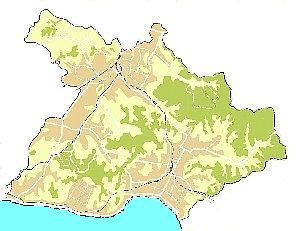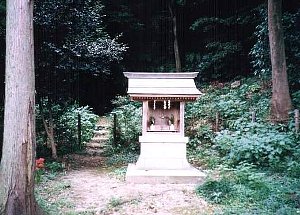How did this area come to be called Kamakura?
There are various theories about the origin of the place name, Kamakura. The following is the most probable.

The central part of Kamakura is surrounded by hills on three sides--north, east, and west--and the fourth, south side is open to the sea. This lay of the land was likened to a stone or earthenware cooking stove used in the old days, kamado (竃) in Japanese, and also to a warehouse, kura (倉), because both kamado and kura have one open side and three closed ones. The combined name, kamado kura, it is said, gradually turned into the name, Kamakura.
Another theory is based on a legend that dates back to the seventh century.
Fujiwara no Kamatari (藤原鎌足, 614-669), the founder of the Fujiwara family that prospered in the Heian period (794-1185/92), stopped by at Yuigahama (由比ガ浜) on his way to Kashima Jingu Shrine (鹿島神宮) in present-day Ibaraki Prefecture, where he was to pray for peace and order in the eastern part of Japan. That night he had a dream in which an old man appeared and promised to support him. The next morning he found at his bedside a spear with a sickle-like blade, the type known as kamayari (鎌槍). Kamatari respectfully enshrined it at a spot in Okura (大蔵). The kama in kamayari and the kura in Okura are said to have produced the name, Kamakura.

*Kamatari Inari Shrine, which is closely connected with Fujiwara no Kamatari, within the grounds of Jomyoji Temple in Jomyoji. A plaque next to the Shrine reads as follows.
|
When and in what documents did the place name Kamakura appear in early history?
The place name, Kamakura, was already being used in the Nara period (710-794).1. The name, Kamakura, is found in the Kojiki (古事記), Record of Ancient Matters, compiled in 712 by O no Yasumaro (太安万侶, ?-723). More precisely, the term "Kamakura no wake" (鎌倉之別) appeared in it as a name for local rulers supposedly here as representatives of the central government in Nara.
2. An inscription on a wooden tablet bore the characters for a place name, "Kamakura-koori Kamakura-sato" (鎌倉郡鎌倉里) and the date, the fifth year of the Tempyo era (天平五年, corresponding to 733) in Indian ink. The wooden tablet was unearthed at an excavation site in the city of Ayase (綾瀬市) located in the center of Kanagawa Prefecture (about 15 km northeast of Kamakura.)
3. Furthermore, four poems in connection with Kamakura are found in the Man'yoshu (万葉集): Japan's oldest anthology of poetry. It includes more than 4,500 short and long verses composed in the seventh and eighth centuries by people ranging from emperors and nobles to the anonymous.
While three of the four poems were love songs, the fourth one was a man's farewell to his mother, composed just prior to his departure to take up defense duties as a sakimori (防人) in Kyushu.